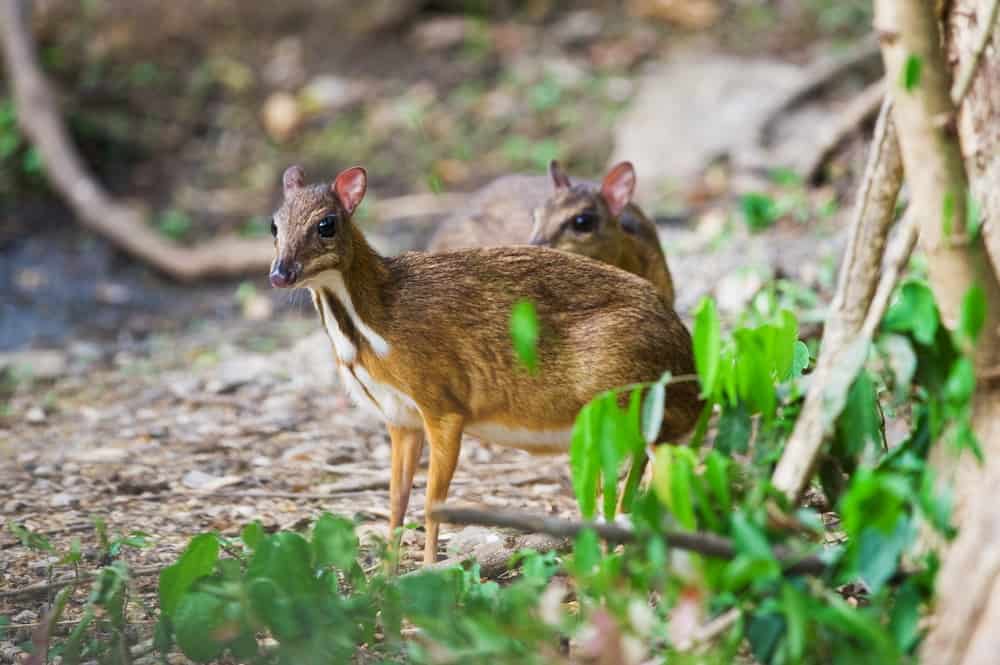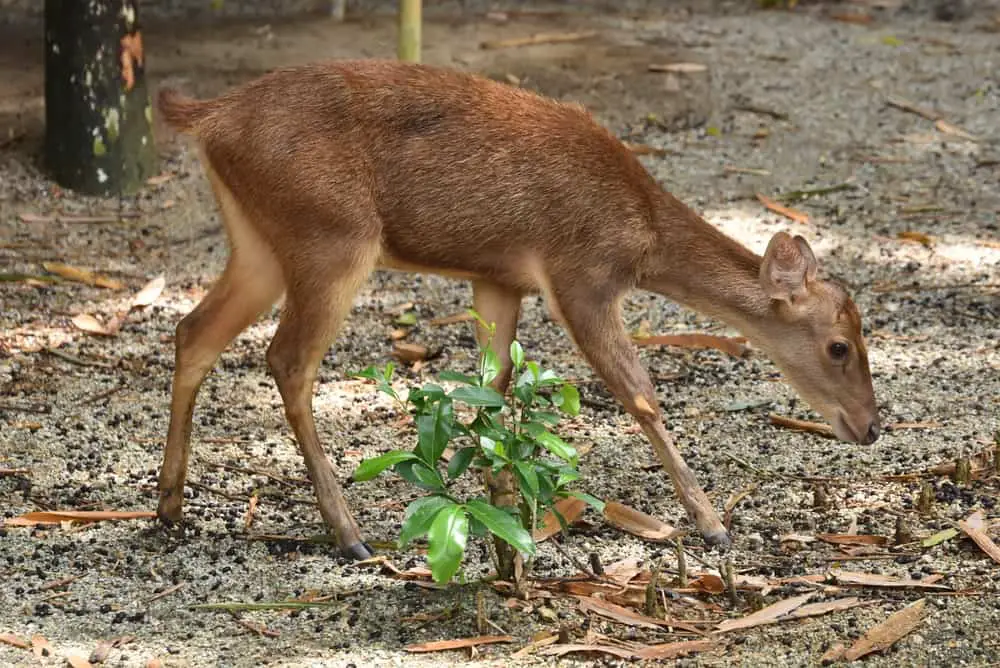Williamson’s mouse-deer (Tragulus williamsoni) is a rare species of even-toed ungulate native to the deciduous forests and grasslands of Central Asian countries.
This small mammal has an evolutionary history that dates back over 11 million years, making it one of the oldest surviving members in its family.
Its distinctive features include long ears and short legs, giving it an appearance similar to both deer and rodents.
Due to its elusive nature, this species was only recently discovered by scientists in 2010 and identified as having unique characteristics from other Tragulids.
The purpose of this article is to provide a detailed overview on Williamson’s mouse-deer including its habitat, physical description, diet, behavior patterns, adaptations for survival and conservation status.

Overview Of Williamson’s Mouse-Deer
Tucked away from the hustle and bustle of human civilization, deep in the tropical forests of Southeast Asia lies one of nature’s most mysterious creatures – Williamson’s Mouse-deer (Tragulus williamsoni).
This ancient species has been shrouded in secrecy for centuries, with little known about its behavior or biogeography.
Recent studies have shed light on this enigmatic mammal’s mating strategies, which appear to vary among individuals and geographic regions.
Williamson’s mouse-deer is a small ungulate that typically weighs between 1 – 2 kg and measures just 30 cm tall at shoulder height.
These timid animals inhabit lowland rainforests throughout parts of Malaysia, Singapore, Thailand, Cambodia, Vietnam and Indonesia.
Studies suggest that there are two distinct subspecies: Tragulus napu williamsoni found along the Malay Peninsula; and T. w. kanchil inhabiting Sumatra, Borneo and Java islands.
Due to their cryptic nocturnal habits, exact population numbers remain unknown but they are thought to be quite rare across all locations where they occur.
Habitat And Distribution
The Williamson’s mouse-deer (Tragulus williamsoni) is a species of even-toed ungulate found in forests and grasslands of Southeast Asia. Its range stretches from the Malay Peninsula to western Indonesia, where it has been observed on the islands of Sumatra, Java, Borneo, and Palawan. Though its distribution across these regions is relatively widespread, its population density remains low due to habitat destruction and hunting pressures.
In terms of migration patterns, this species can cover large distances; however some seasonal local movements have also been reported.
Its habitats generally consist of tropical rainforests with dense understory vegetation including shrubs and trees as well as open grasslands with scattered woody plants. It has an extreme sensitivity to human disturbance which further limits suitable areas for settlement.
As such, major threats include deforestation caused by logging activities and agricultural expansion as well as overhunting by humans. Recent conservation efforts are attempting to protect vulnerable populations but much more needs to be done in order to ensure the long-term survival of this unique species.
Physical Description
Tragulus williamsoni is a small species of mouse-deer that can be found in the tropical forests of Thailand, Malaysia and Indonesia. It has short fur which varies from yellowish to reddish brown on its upperparts and white beneath with distinct black patches around the eyes and neck regions. The fur texture ranges from coarse and bristly hairs to softer ones near the abdomen.
The body size of Tragulus williamsoni typically ranges from 30 cm – 50 cm head-body length, with a tail length ranging between 10 cm – 15 cm. Their shoulder height averages about 20 cm, while their weight usually falls between 1 kg – 2 kg. Table 1 below summarizes the physical characteristics for this species:
| Characteristic | Measurement | Unit |
|---|---|---|
| Body Size | 30cm – 50cm | Length |
| Tail Length | 10cm – 15cm | Length |
| Shoulder Height | 20cm | Length |
| Weight | 1kg – 2kg | Mass |
Due to its relatively small size and cryptic coloration, T. williamsoni is well adapted to living in dense vegetation where they feed mainly on fruits, leaves, flowers buds as well as some insects. This adaptation makes it difficult to observe them directly in their natural habitats but nonetheless they have been reported by local villagers over time throughout Southeast Asia’s rainforests.
Diet And Foraging Behavior
The Williamson’s Mouse-Deer is a species of small ungulate native to the island of Luzon in the Philippines.
This diminutive mammal stands out from other members of its genus due to an interesting statistic: it weighs less than one kilogram and can measure up to 40 centimeters long!
Despite such size constraints, this species has adapted well to its environment by honing several foraging strategies that help them acquire their dietary preferences.
When searching for food, T. williamsoni primarily feeds on leaves and fruits found low on trees or shrubs while also occasionally consuming flowers, bark, insects and small invertebrates when available.
To maximize their intake they employ three main tactics: browsing vegetation directly with their mouths; using specialized incisors to chew through leafs and stems; as well as utilizing their prehensile tail as a fifth limb while feeding in hard-to-reach areas like canopy branches.
These abilities are further enhanced by their sharp senses which allow them to quickly detect changes within their surroundings thus avoiding predators during daytime hours when most active.
Reproduction And Social Behavior
The breeding strategies of the Williamson’s mouse-deer species are monogamous and typically occur during December, January and February.
Males will actively defend their female mate from other males which can lead to violent fights with bites or kicks.
Females will give birth to one offspring at a time with an average gestation period of six months.
Williamson’s mouse-deers have been observed in two types of group dynamics; solitary behavior and small groups (usually comprising 2 – 4 individuals).
The adult females and juveniles live together in groups while male adults tend to be more solitary, generally leaving the group upon maturity.
When living in groups they feed separately but cohabitate within close proximity.
During mating season, multiple males may form temporary social bonds in order to compete for a single female partner.
This behaviour is known as lekking behaviour, where males gather around the same area in order to show off their physical abilities such as antlers and vocalisations intended to attract potential mates.

Adaptations For Survival
The Williamson’s mouse-deer is an incredibly adaptable species. Their social behavior and reproductive strategies ensure their survival in a variety of habitats, but they also possess other adaptations that help them to survive in the wild.
These include cryptic coloration and location within dense vegetation. The Williamson’s mouse-deer have evolved coats with tones that blend into their surroundings making it difficult for predators to spot them even when they are moving or feeding. This camouflage allows these animals to remain hidden whilst grazing on grasses without detection from potential threats such as cats and birds of prey.
In addition, they often take shelter among foliage and shrubs which provides further protection from aerial hunters by masking the deer’s silhouette against the terrain. Dense vegetation also creates more cover for young offspring providing a safe environment for nursing mothers as well as allowing juveniles to rest undisturbed until they reach sexual maturity.
Threats And Conservation Status
The Williamson’s mouse-deer is threatened by various human activities, especially those related to habitat destruction and poaching. These threats have posed a significant risk to the species’ survival in its natural environment.
Habitat destruction has significantly affected this species as it requires large areas of lowland rainforest for its survival. Human activities such as logging and conversion of forested land into agricultural or urban development are major causes of deforestation throughout Southeast Asia. This has resulted in numerous local extinctions due to loss of suitable habitats for the Williamson’s mouse-deer.
In addition, hunting and commercial trade pose another serious threat to this species’ population. The animal’s small size makes them an attractive target for poachers, despite their protected status under national law. In some places, they are also hunted for food purposes, further diminishing their numbers in certain locations.
They are particularly vulnerable due to their slow reproductive rate; therefore conservation efforts need to focus on both reducing levels of poaching and preserving existing rainforest habitats if this species is to survive in the long term.
Interesting Facts About Williamson’s Mouse-Deer
Williamson’s mouse-deer is an incredibly unique mammal found in Southeast Asia, and is the smallest species of even-toed ungulate in the world. Amazingly, these small creatures weigh between 2 to 5 kilograms and can reach lengths up to 50 centimeters!
The conservation status for this species of deer has been listed as Vulnerable by the IUCN since 2008 due to its decreasing population numbers. There are a number of efforts being undertaken in order to aid their recovery, such as:
- Breeding habits:
- Restricting hunting activities
- Establishing protected areas/sanctuaries
- Conservation efforts:
- Increasing public awareness about Williamson’s mouse-deer
- Research on habitat use & changes over time
As such, great strides have been made towards preserving the future of this remarkable creature. Protections are still needed, however, if we want to ensure the sustainability of the population throughout its range.
Hopefully with continued education and conservation measures, we will be able to safeguard this incredible animal from extinction.
Conclusion
The Williamson’s mouse-deer is an interesting mammal, and one that has adapted to its environment well.
It can be seen in many parts of Southeast Asia, where it uses its small size and excellent camouflage coloring to hide from predators.
Its diet consists mainly of vegetation, which it forages for using its keen sense of smell.
Reproduction takes place during the monsoon season with a single offspring being born after a gestation period of around three months.
With further understanding of this species’ habits and adaptations, humans must take steps to protect them from threats such as hunting or habitat loss due to deforestation.
The future of the Williamson’s mouse-deer depends on our ability to recognize their importance within their ecosystem and ensure they have a safe haven going forward into the future.
As ambassadors for conservation efforts worldwide, they serve as reminders that even small animals play an essential role in keeping nature balanced and healthy.

